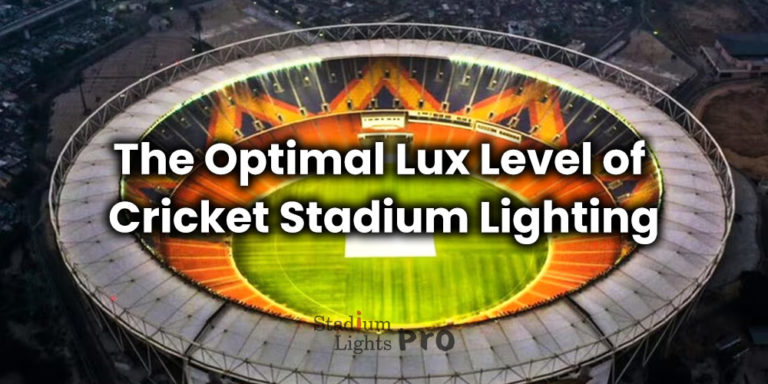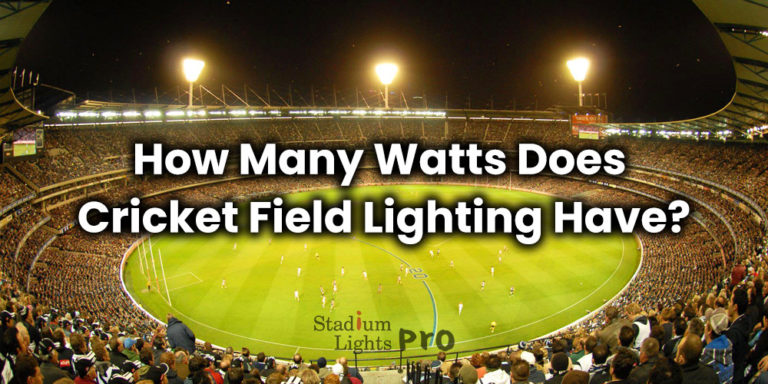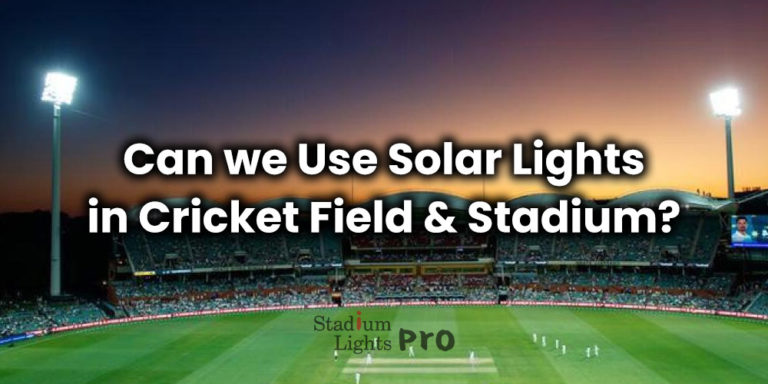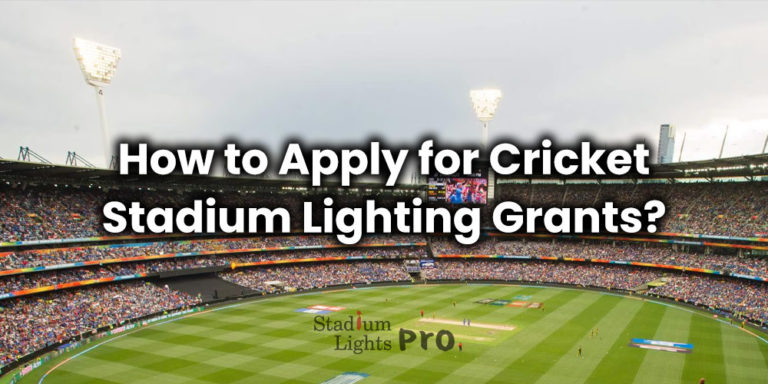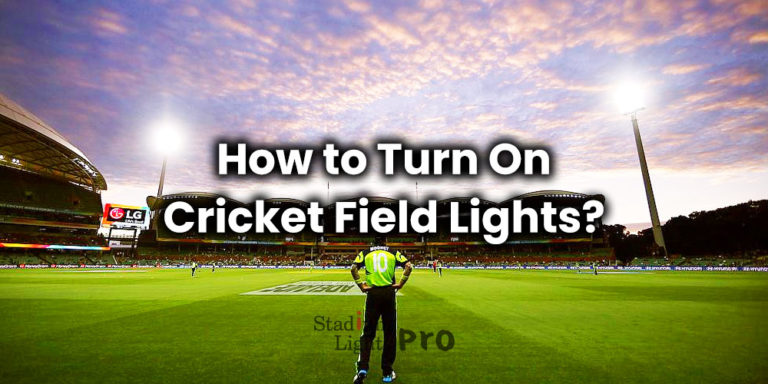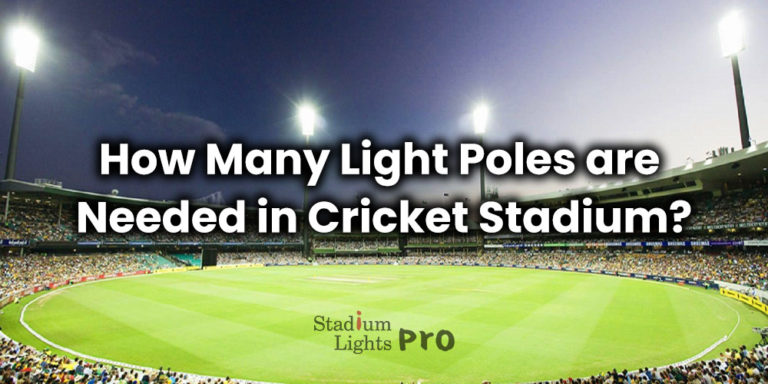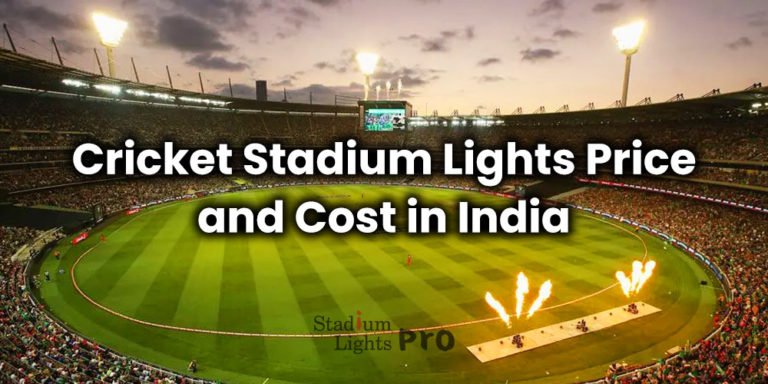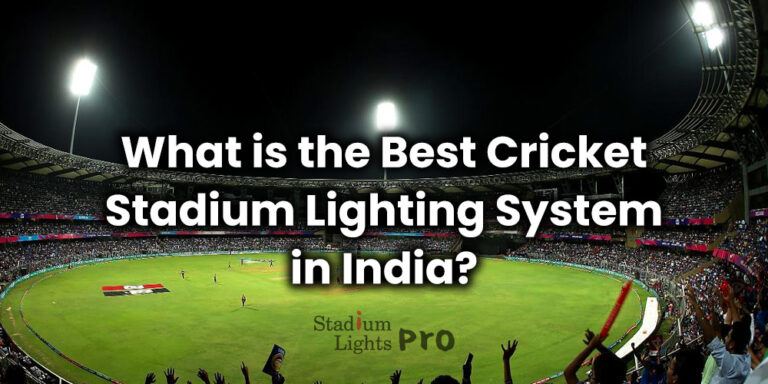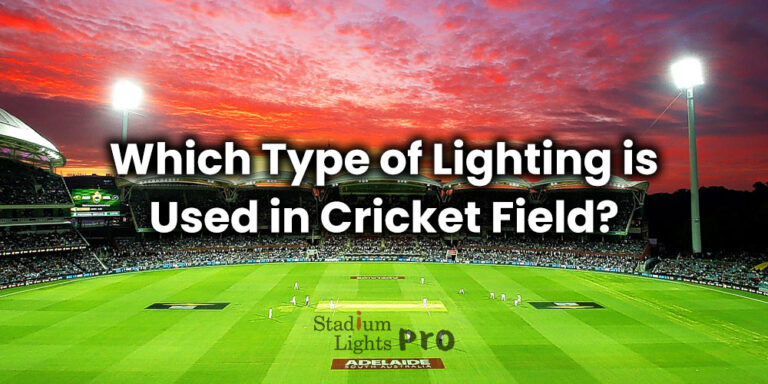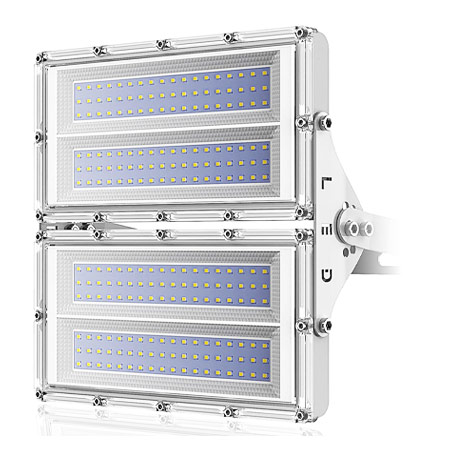
Cricket Field Lighting
Welcome to our comprehensive guide on cricket field lighting! In this page, you will delve into the fascinating world of cricket field lighting and gain valuable knowledge about various aspects, such as the types of lights used, the number of lights required, and how to select the ideal lighting solutions.

Whether you are an avid cricket enthusiast, a stadium owner, or involved in the management of cricket events, this page will equip you with the essential information to create an optimal lighting setup that enhances player performance, ensures fair gameplay, and captivates spectators. Let’s explore the intricacies of cricket field lighting and discover the key factors to consider when illuminating these iconic sports venues.
Table of Contents
ToggleHow to Achieve the Best Cricket Field Lighting Design?
Lux Levels and Their Role in Visibility
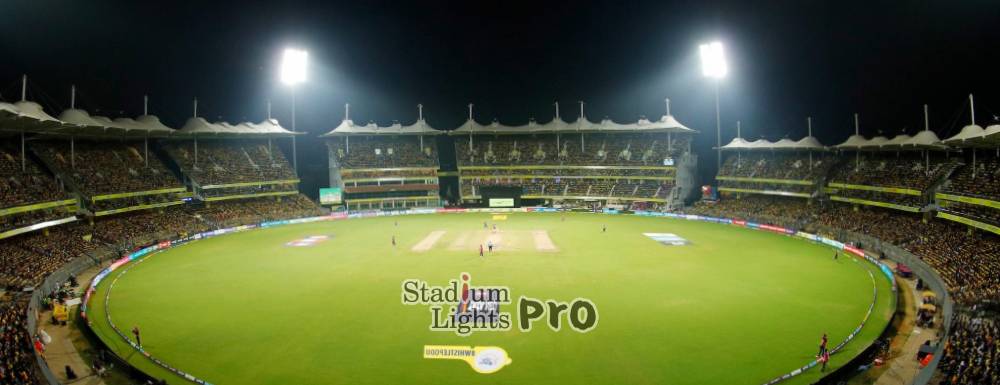
Lighting design for cricket fields demands meticulous planning due to the sport’s unique dynamics, which involve high-speed ball movement, large field dimensions, and the requirement for extended visibility under various play conditions. Lux levels, the measure of light intensity, play a pivotal role in determining how well the field is illuminated for both players and spectators.
For training fields and recreational cricket, lux levels in the range of 250 to 300 lux are generally sufficient. These levels provide adequate visibility without excessive power consumption. However, as the level of competition increases, so do the lux requirements. Professional club matches, particularly those not broadcasted, require illumination levels of at least 800 lux. For televised or international matches, especially those filmed in high-definition or ultra-high-definition formats, lux levels may need to reach 2000 lux or even higher.
This intensity ensures that fast-moving balls can be tracked clearly, whether they are being bowled at over 90 mph or hit toward the boundary. It also allows cameras to capture every detail without distortion. Uniform lighting coverage across the entire playing surface, including the central pitch and expansive outfield, is essential to avoid visual dead zones that hinder gameplay and reduce broadcast quality.
| Match Type | Average Lux Level | Uniformity Ratio (Min/Average) | Number of LED Fixtures | Total Wattage (LED) |
|---|---|---|---|---|
| Training / Recreational | 250–300 lux | ≥ 0.4 | 20–30 fixtures | 60–150 kW |
| Club Matches (Non-TV) | 500–800 lux | ≥ 0.5 | 30–50 fixtures | 150–300 kW |
| Regional Competitions | 1000–1200 lux | ≥ 0.6 | 50–70 fixtures | 300–450 kW |
| National / HD Broadcast | 1500–2000 lux | ≥ 0.7 | 70–100 fixtures | 400–600+ kW |
| International / 4K Broadcast | 2000+ lux | ≥ 0.75 | 80–120+ fixtures | 500–700+ kW |
Uniformity and Its Influence on Gameplay
Lighting uniformity is as critical as lux levels in ensuring a smooth visual experience. Inconsistent lighting can cause shadows or hot spots, which interfere with a player’s depth perception and reaction time. To maintain visual balance, a uniformity ratio—defined as the minimum illuminance divided by the average illuminance—is used to assess consistency across the field.
For non-televised matches, a uniformity ratio of at least 0.5 is generally acceptable. For professional and broadcast-standard lighting, the target increases to 0.7 or higher. Achieving such levels means the light intensity does not fluctuate drastically, ensuring all areas of the field are equally playable and visible.
Strategic pole placement and precise fixture aiming angles are the foundation of uniform lighting. Poles should be symmetrically positioned, and the luminaries mounted at consistent heights. Beam spread must be optimized to eliminate overlap while ensuring no part of the field is left dim. When this is achieved, players benefit from an uninterrupted visual field, making split-second decisions more intuitive and reducing the risk of injury due to unexpected visibility shifts.
Determining the Number of Fixtures Required

The question of how many lighting fixtures are needed for a cricket field hinges on field size, competition level, fixture type, beam angles, and pole height. A typical cricket ground, with boundary radii ranging from 70 to 80 meters, demands comprehensive illumination. For international or high-level televised matches, approximately 60 to 100 high-output LED floodlights may be necessary, often mounted across 6 to 8 tall lighting masts.
Lower-tier grounds, which cater to community or club-level matches, might suffice with 30 to 50 fixtures if the design and technology are efficient. The determining factor is not just the number of fixtures but how effectively each one disperses light. High-quality LED systems with precision-engineered optics can cover larger areas more uniformly, reducing the total fixture count required to meet lux and uniformity standards.
The reuse of existing infrastructure, such as light poles from older setups, may further affect fixture requirements. When poles are already in place, the design must adapt to their location and height, often necessitating customized fixture selections and aiming angles to preserve uniformity and brightness.
Wattage and Energy Considerations
Cricket field lighting must also consider total system wattage, which directly impacts both operational costs and energy efficiency. LED systems are highly effective in this domain, with individual fixtures typically consuming 1000 to 2000 watts, depending on the lumens output and beam characteristics. For a fully equipped, professional-grade field, the total installed wattage can range from 200 kilowatts (kW) to over 600 kW.
Legacy systems, such as metal halide fixtures, often required significantly higher wattage to deliver equivalent brightness, making them less efficient and more costly over time. LEDs, in contrast, offer high luminous efficacy, meaning they produce more light per unit of power consumed. This translates into reduced electricity usage, lower carbon emissions, and ultimately, lower long-term operating costs.
Additionally, many LED systems now come with smart energy management capabilities, allowing operators to control brightness levels and optimize lighting schedules. This means lighting can be tailored to specific events, reducing wastage during non-peak periods and extending fixture life.
Managing Glare and Enhancing Player Comfort
Glare is a major issue in cricket lighting design, especially due to the elevation and velocity of the ball during play. If players, particularly fielders or batsmen, are momentarily blinded by intense or misdirected light, their performance can suffer, and the risk of injury increases. Therefore, managing glare is essential to player safety and comfort.
Modern LED floodlights are built with glare-reducing optics and shielding accessories that focus light downward and toward designated playing zones. Well-aimed fixtures prevent light from entering the players’ line of sight, especially when positioned to avoid interference during aerial plays. The central pitch and surrounding areas benefit from soft, even transitions of light, which reduce visual fatigue and allow players to maintain focus.
This is particularly valuable during night matches or in venues surrounded by reflective surfaces. By using LEDs with custom beam control, designers can mitigate both direct glare and secondary reflections, enhancing overall playability and visibility across the entire field.
Flicker-Free Lighting for Broadcast and Replay
In the era of slow-motion replays and ultra-high-definition television, flicker-free lighting is non-negotiable. Any inconsistency in light output becomes dramatically visible when frames are captured at high speeds, often resulting in poor footage that undermines viewer experience.
High-quality LED systems incorporate flicker-free drivers that maintain a constant power flow, even under varying electrical loads. This ensures stable luminance at all times, making the lighting suitable for frame rates commonly used in professional sports broadcasting—such as 120 fps or higher.
For players, this consistency helps in identifying ball spin, seam orientation, and subtle field movements that could influence gameplay. For broadcasters and fans, it ensures that every detail is captured with clarity, enhancing both the technical and aesthetic quality of the match.
Integrating Advanced Lighting Controls
Advanced lighting controls have revolutionized how cricket field lighting is managed. Today’s systems allow for dynamic light modulation, meaning brightness can be increased for key matches or dimmed during casual use. Operators can establish lighting presets for different scenarios, from training sessions to full-stadium events.
Digital control interfaces, often operated wirelessly or via cloud platforms, allow for remote access, scheduling, diagnostics, and automation. These systems can also integrate with smart sensors that respond to environmental conditions such as daylight or occupancy, automatically adjusting lighting levels as needed.
This flexibility leads to significant energy savings while improving field usability. Customizable light zones, interactive control dashboards, and integration with venue-wide systems (e.g., security or event management) make lighting not just a utility, but a vital part of operational strategy.
Best Practices for Cricket Field Lighting Design
Achieving the best cricket field lighting design involves more than just meeting technical specifications—it requires a holistic approach that considers performance, sustainability, and user experience. The process begins with a thorough site analysis, evaluating factors such as soil conditions for pole installation, local weather patterns, and community concerns about light pollution or glare.
Lighting designers often employ 3D simulation software to test various layouts, beam spreads, and fixture types. These simulations help predict lux levels, shadow patterns, and glare risks, enabling fine-tuning before installation begins. Such precision not only improves the end result but also reduces costly revisions later.
Fixture selection is equally crucial. Each light should meet rigorous standards for durability, ingress protection (IP rating), color rendering index (CRI), and thermal management. The inclusion of flicker-free operation and anti-glare design ensures suitability for modern sports environments. Once installed, a routine maintenance plan should be implemented to monitor performance, clean lenses, adjust aim angles, and replace components as needed.
By integrating these best practices, cricket venues can deliver superior lighting quality that enhances the experience for players, spectators, and broadcasters alike—ensuring the sport can be enjoyed to its fullest, no matter the time of day or level of play.
What Types of Lights Are Used in Cricket Fields
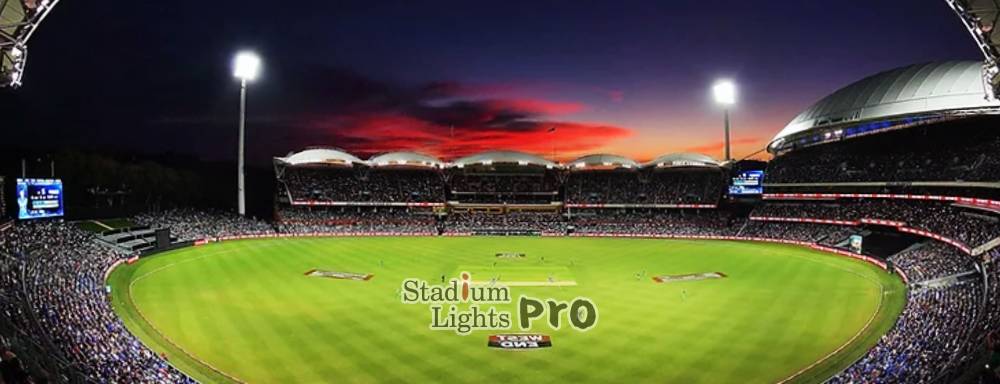
Transition from Metal Halide to LED
Metal halide lamps were once the backbone of cricket field lighting. These high-intensity discharge (HID) lights were valued for their ability to produce a powerful, white light suitable for nighttime matches. Their color rendering, although decent, did not always provide the clarity needed for fast-paced action or televised coverage. Additionally, metal halide systems came with several operational drawbacks: long warm-up times, frequent re-strikes after power interruptions, and high maintenance costs due to limited lifespans and sensitivity to weather conditions.
With advancements in lighting technology, LED lights have overtaken metal halide as the preferred choice for cricket grounds. LED (light-emitting diode) systems deliver numerous advantages, including instant illumination, significantly reduced energy consumption, and lifespans that often exceed 50,000 hours. These benefits translate into lower operational costs and fewer disruptions during matches or training sessions. LEDs are also more resistant to shock and vibration, making them ideal for outdoor installations that must withstand changing weather.
LED Floodlights for General Illumination
Among the various types of LED lighting used in cricket fields, LED floodlights are the most prevalent. These fixtures are engineered to provide broad, uniform light coverage across large areas, making them ideal for illuminating the entire outfield and boundary regions. High-output LED floodlights are mounted on tall masts—usually between 25 to 50 meters high—allowing light to reach long distances without creating excessive shadows.
Thanks to precision optics, modern floodlights can focus light exactly where it is needed, reducing light spill into neighboring areas and minimizing glare. Their high lumen-per-watt efficacy also means that fewer fixtures are required to achieve the same lux levels as older technologies. This efficiency helps cut down installation and electricity costs while maintaining optimal lighting performance.
Spotlights for Targeted Illumination
In certain areas of the field—especially the central pitch and bowler’s run-up zones—more focused lighting is necessary. This is where LED spotlights come into play. Unlike floodlights, which distribute light across wide angles, spotlights provide narrow beam angles for targeted illumination. They are used to enhance visibility in zones where precision and intensity are most critical, ensuring that fast deliveries, ball spin, and footwork are clearly visible to players, umpires, and spectators alike.
These lights are also beneficial for high-definition broadcasting, as they help eliminate shadows and improve contrast in key gameplay areas. Spotlights can be mounted alongside floodlights or installed separately, depending on the lighting design requirements and the specific needs of the venue.
Portable and Temporary Lighting Options
For training grounds, smaller venues, or temporary events, portable lighting systems are often employed. These setups may include mobile LED towers or trailer-mounted floodlight units, which can be transported and adjusted as needed. While not suitable for high-level competitive play, they are useful for practice sessions, local tournaments, or situations where permanent infrastructure is unavailable.
These portable systems typically use energy-efficient LED fixtures and run on either grid power or generators. They are quick to set up and offer flexibility in field layout and usage. Some modern versions even come with remote control features and battery backup, offering more control and sustainability.
Glare-Reducing Fixtures and Optical Enhancements
To support the visual comfort of players and enhance broadcast quality, many cricket fields now use glare-reducing fixtures. These lights incorporate special shielding, diffusers, and micro-lens technology to minimize harsh brightness and direct glare away from sensitive sightlines. This is particularly crucial when fielders are tracking a high ball under night skies or when a batsman is facing fast-paced deliveries under intense lighting.
The ability to precisely shape and direct the beam is another advantage of advanced LED systems. With tailored optics, light can be distributed in consistent patterns, eliminating dark spots and reducing overlapping hotspots that might cause visual distraction or uneven brightness across the field.
Choosing the Right Mix of Lighting Fixtures
An effective lighting system for a cricket field doesn’t rely on just one type of light. Instead, it requires a carefully balanced combination of floodlights for wide-area coverage, spotlights for intensity in key zones, and specialized fixtures for minimizing glare and flicker. The specific configuration depends on factors like field size, level of competition, and whether the venue will host televised matches.
Cricket field lighting designers often run computer simulations to assess the performance of different light types in various layouts. This ensures that the selected fixtures can deliver the required lux levels, color uniformity, and visual clarity while meeting local energy codes and minimizing light pollution.
Features of Cricket-Specific LED Floodlights
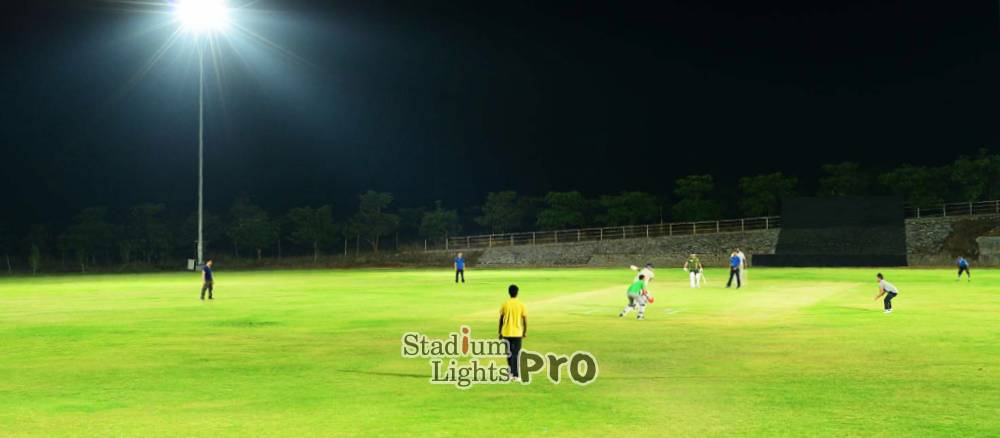
High Lumen Output and Long Throw Capabilities
Cricket-specific LED floodlights are engineered for high-intensity performance, delivering over 100,000 lumens per fixture to ensure every part of the field is brightly illuminated. These high-output systems are necessary not only because of the sheer size of cricket grounds but also because of the ball’s small size, high velocity, and the 360-degree range of play. Cricket’s unique oval-shaped layout demands lighting solutions that offer both wide coverage and long throw, allowing fixtures mounted on tall masts to effectively reach the center pitch and deep outfield without losing intensity.
To meet these demands, LED floodlights often utilize medium to narrow beam angles. This configuration ensures the light travels far enough while maintaining intensity and reducing spill beyond the stadium’s perimeter. By adjusting the optics for a tailored throw distance, lighting designers can ensure that lux levels remain consistent across the playing surface, minimizing dark zones that might affect gameplay or spectator experience.
Modular Design for Easier Maintenance
One of the most practical innovations in modern sports lighting is the modular architecture of LED floodlights. These lights are often built in detachable segments, allowing stadium operators to replace or repair components such as drivers, diodes, or heat sinks individually. Instead of discarding the entire unit during a malfunction, technicians can isolate the faulty part, perform targeted maintenance, and quickly restore the light to full operation.
This modularity improves the overall lifespan and sustainability of the lighting system. It also minimizes downtime, which is crucial for stadiums with frequent matches or tight event schedules. In large-scale venues, where dozens of floodlights are mounted on tall poles, the ability to service just one module without dismantling the entire assembly can save time, reduce labor costs, and improve safety during maintenance operations.
True-to-Life Color Rendering
In cricket, color differentiation plays a role in how effectively players and viewers perceive action on the field. LED floodlights with a high color rendering index (CRI)—typically rated above 80 or even 90—allow for accurate reproduction of all colors. This feature ensures that a red or white ball contrasts clearly against the grass, player uniforms, and pitch surface under artificial lighting. Umpires rely on this clarity to make fine judgments, while broadcasters need accurate colors to maintain visual quality for viewers watching in HD or 4K formats.
High CRI lighting also contributes to a better visual experience for in-person spectators, helping them follow the ball in motion and observe subtleties in player expressions or movements. This color fidelity becomes even more relevant in day-night matches, where the transition from natural to artificial light must be smooth and seamless.
Weatherproofing and Resistance to Harsh Conditions
Outdoor cricket stadiums are often exposed to a wide range of environmental conditions, from monsoon rains to intense summer heat and dust storms. To cope with such elements, cricket-specific LED floodlights are built with robust weatherproofing. The best models feature IP66 or higher ingress protection ratings, which means they are fully sealed against dust and powerful water jets. This level of protection ensures uninterrupted operation even during torrential rain or high winds.
In addition to waterproofing, many fixtures are coated with anti-corrosive materials to withstand salty air in coastal regions or industrial pollution in urban areas. These corrosion-resistant coatings are also applied to supporting brackets and mast assemblies, extending the structural integrity of the entire system over time. This resilience makes LED systems a dependable long-term investment, reducing the frequency of repairs or premature fixture replacements.
Impact Resistance and Vibration Protection
A less visible but equally valuable characteristic of modern LED sports lighting is impact resistance. Cricket venues are often subject to physical shocks from ball strikes, equipment movement, or mast vibrations due to wind. Quality floodlights are constructed with reinforced housings, shock-absorbing mounts, and vibration-resistant components that prevent internal damage or dislodgement. These features are especially critical on masts exceeding 30 meters, where the top structure can sway under pressure or gusts.
Impact-resistant designs help protect delicate internal elements such as the LED chips and driver circuitry, preserving light consistency and reducing the risk of sudden failure during gameplay. This feature adds an extra layer of operational security during high-stakes tournaments where lighting continuity is non-negotiable.
Thermal Management and Overheat Protection
High-output LEDs generate considerable heat, particularly during extended evening matches. To ensure consistent brightness and prevent early burnout, advanced thermal management systems are integrated into cricket-specific floodlights. These include passive aluminum heat sinks with fin-like structures that dissipate heat effectively, as well as active thermal control systems that monitor fixture temperature and regulate output accordingly.
Some systems also include smart sensors that trigger automatic dimming or shutoff protocols if overheating is detected. This protective feature safeguards the lighting infrastructure, maintains energy efficiency, and ensures that performance does not degrade over time due to heat-induced wear.
Compact and Lightweight Designs for Easier Installation
Although high in performance, many modern cricket LED fixtures are designed to be relatively compact and lightweight. Slim-profile floodlights reduce wind load on poles and make mounting easier during installation. This design is especially advantageous when retrofitting existing masts or installing lights in urban venues with structural constraints.
Lighter fixtures also simplify mast rotation or aiming adjustments and reduce the load on hoisting equipment. Despite their smaller size, these fixtures maintain the same luminous intensity and optical quality, demonstrating how LED engineering has evolved to combine form and function.
Integration with Smart Lighting Controls
Cricket stadiums increasingly adopt smart lighting technologies that allow centralized control of all floodlights. Fixtures must be compatible with DMX, DALI, or wireless control systems, enabling operators to program light sequences, dim fixtures during downtime, or trigger dynamic effects during ceremonies or replays. These systems not only enhance event presentation but also optimize energy use and extend the life of the lighting system.
LED floodlights designed for cricket are often pre-configured to sync with these smart control platforms, providing real-time feedback on power consumption, temperature, and performance status. When integrated with venue management software, this feature offers a complete, efficient, and user-friendly lighting ecosystem.
Funding of Cricket Stadium Lighting
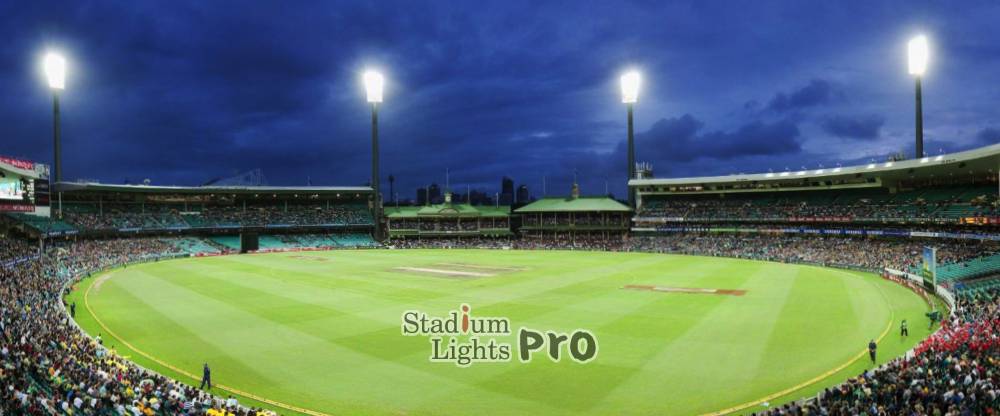
The Scale of Investment and Financial Need
Installing or upgrading lighting for a cricket stadium is a major financial undertaking, with costs ranging from $50,000 to several million dollars depending on the scale and purpose of the facility. While the expense may seem high, the long-term benefits—including enhanced playability, extended hours, and increased revenue potential—often justify the cost. Night matches, televised events, and expanded training windows create opportunities that turn lighting systems into valuable strategic assets.
Where the Money Comes From
Funding for cricket lighting projects typically comes from a diverse mix of sources. Government grants are common, especially through departments focused on sports, infrastructure, or regional development. Cricket boards and federations also allocate significant funds for club-level and professional facility improvements, particularly when aligned with strategic goals like player development or tournament hosting.
On the private side, corporate sponsorships play a growing role. In return for branding, signage, or naming rights, sponsors often fund a significant portion of the lighting system. Clubs can also rely on community-driven fundraising, such as donations, events, or crowdfunding platforms, to support their budget. Some projects are financed through lease-to-own agreements or loans, helping clubs spread the investment over multiple years as they generate income from night games and events.
Understanding Eligibility Requirements
Eligibility criteria vary by funding source but typically include being a registered club or nonprofit, demonstrating a clear need for lighting, and showing how the project will benefit the broader community. Some funders require applicants to be affiliated with official cricket governing bodies.
Most programs expect clubs to provide a co-contribution, either in the form of direct funding or in-kind support like volunteer labor. A successful application usually includes a comprehensive project plan, outlining technical specs, usage forecasts, and expected community impact. For environmentally focused grants, you may also need to provide data on energy savings, carbon footprint reduction, or the use of certified LED technologies.
How to Apply for Lighting Grants and Sponsorship
The first step in the application process is to identify relevant funding programs. These are often listed on government or cricket federation websites, complete with application deadlines and requirements. Once a program is selected, the club must prepare a detailed proposal. This should include the scope of work, lighting designs, budget estimates, and expected benefits.
Strong proposals are backed by supporting documents such as vendor quotes, registration certificates, letters of endorsement, and community engagement plans. For sponsorships, it’s useful to include marketing metrics and potential brand exposure to attract commercial interest.
After submission, it’s important to stay in contact with funding bodies. Some may request interviews, additional documents, or site visits before approval. Once funding is secured, organizations must meet reporting and compliance obligations, including tracking progress, submitting expense reports, and demonstrating that milestones are met.
Long-Term Planning and Financial Sustainability
Effective lighting projects require a long-term view, not just short-term installation budgets. Clubs should plan for maintenance, upgrades, and replacement cycles from the outset. Investing in high-quality LED fixtures reduces these future costs due to extended lifespans and minimal maintenance. When paired with smart controls, operating costs drop even further by enabling zoned lighting, automatic dimming, and scheduled use.
To further enhance sustainability, clubs should look to maximize facility usage by hosting non-cricket events, renting to other sports, or offering community programming. These added revenue streams help cover recurring expenses and demonstrate the broader value of the investment. Aligning projects with community goals and environmental priorities also opens the door to additional grants and goodwill.
With a clear financial strategy, technical expertise, and community alignment, cricket clubs can successfully deliver lighting systems that provide decades of value—both on and off the field.
Conclusion
Cricket field lighting has evolved into a sophisticated blend of technology, strategy, and community engagement. From optimizing lux levels and uniformity to integrating energy-efficient LED floodlights and smart controls, every detail plays a role in enhancing performance and visibility. With thoughtful planning, the right funding approach, and a focus on long-term value, clubs and stadiums can create lighting systems that not only elevate the game but also serve their communities for years to come.
If you’re planning to upgrade or install cricket field lighting, getting a professional lighting design can make all the difference. A custom lighting layout ensures optimal brightness, uniformity, and energy efficiency based on your specific field dimensions, pole placements, and usage needs. We offer free cricket field lighting design services to help you get started with confidence. Whether you’re working on a local club ground or a professional stadium, don’t hesitate to reach out and request your personalized design. It’s a no-cost, no-obligation way to visualize your project and make informed decisions before investing.
Contact us for a free lighting consultation


